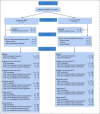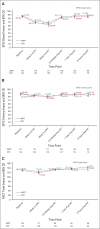Intensity-Modulated Radiation Therapy Reduces Patient-Reported Chronic Toxicity Compared With Conventional Pelvic Radiation Therapy: Updated Results of a Phase III Trial
- PMID: 35960897
- PMCID: PMC9851703
- DOI: 10.1200/JCO.21.02831
Intensity-Modulated Radiation Therapy Reduces Patient-Reported Chronic Toxicity Compared With Conventional Pelvic Radiation Therapy: Updated Results of a Phase III Trial
Abstract
Clinical trials frequently include multiple end points that mature at different times. The initial report, typically based on the primary end point, may be published when key planned coprimary or secondary analyses are not yet available. Clinical Trial Updates provide an opportunity to disseminate additional results from studies, published in JCO or elsewhere, for which the primary end point has already been reported.The purpose of this update was to determine differences in patient-reported chronic toxicity and disease outcomes with intensity-modulated radiation therapy (IMRT) compared with conventional pelvic radiation. Patients with cervical and endometrial cancers who received postoperative pelvic radiation were randomly assigned to conventional radiation therapy (CRT) or IMRT. Toxicity and quality of life were assessed using Patient-Reported Outcomes version of the Common Terminology Criteria for Adverse Events, Expanded Prostate Cancer Index Composite (EPIC) bowel and urinary domains, and Functional Assessment of Cancer Therapy-General. Between 2012 and 2015, 279 eligible patients were enrolled to the study with a median follow-up of 37.8 months. There were no differences in overall survival (P = .53), disease-free survival (P = .21), or locoregional failure (P = .81). One year after RT, patients in the CRT arm experienced more high-level diarrhea frequency (5.8% IMRT v 15.1% CRT, P = .042) and a greater number had to take antidiarrheal medication two or more times a day (1.2% IMRT v 8.6% CRT, P = .036). At 3 years, women in the CRT arm reported a decline in urinary function, whereas the IMRT arm continued to improve (mean change in EPIC urinary score = 0.5, standard deviation = 13.0, IMRT v -6.0, standard deviation = 14.3, CRT, P = .005). In conclusion, IMRT reduces patient-reported chronic GI and urinary toxicity with no difference in treatment efficacy at 3 years.
Trial registration: ClinicalTrials.gov NCT01672892.
Conflict of interest statement
No other potential conflicts of interest were reported.
Figures





References
-
- Peters WA III, Liu PY, Barrett RJ II, et al. : Concurrent chemotherapy and pelvic radiation therapy compared with pelvic radiation therapy alone as adjuvant therapy after radical surgery in high-risk early-stage cancer of the cervix. J Clin Oncol 18:1606-1613, 2000 - PubMed
-
- Sedlis A, Bundy BN, Rotman MZ, et al. : A randomized trial of pelvic radiation therapy versus no further therapy in selected patients with stage IB carcinoma of the cervix after radical hysterectomy and pelvic lymphadenectomy: A Gynecologic Oncology Group study. Gynecol Oncol 73:177-183, 1999 - PubMed
-
- Creutzberg CL, Nout RA, Lybeert ML, et al. : Fifteen-year radiotherapy outcomes of the randomized PORTEC-1 trial for endometrial carcinoma. Int J Radiat Oncol Biol Phys 81:e631-8, 2011 - PubMed
-
- Keys HM, Roberts JA, Brunetto VL, et al. : A phase III trial of surgery with or without adjunctive external pelvic radiation therapy in intermediate risk endometrial adenocarcinoma: A Gynecologic Oncology Group study. Gynecol Oncol 92:744-751, 2004 - PubMed
Publication types
MeSH terms
Substances
Associated data
Grants and funding
LinkOut - more resources
Full Text Sources
Other Literature Sources
Medical
Research Materials

